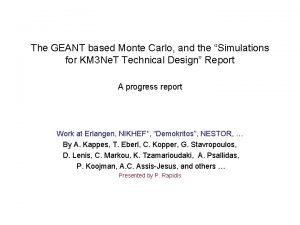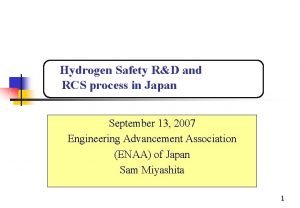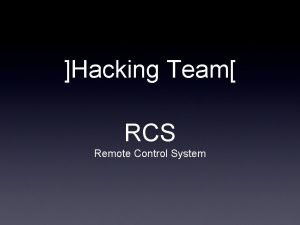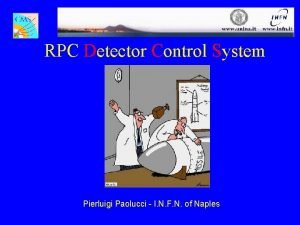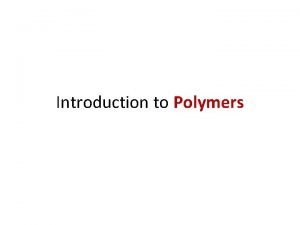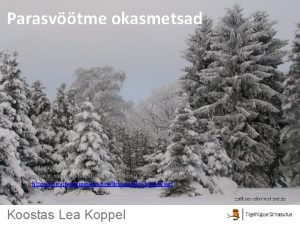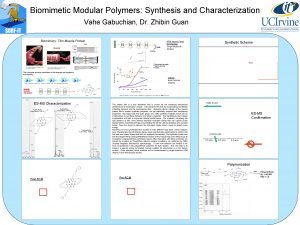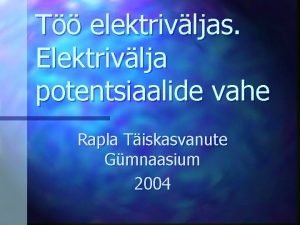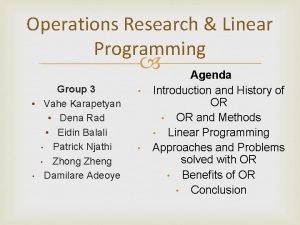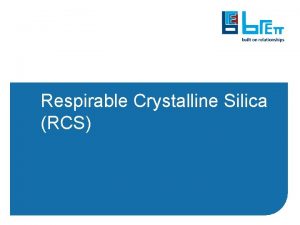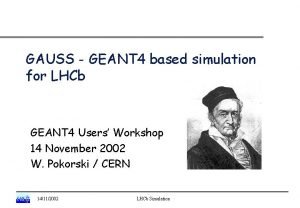GEANT Simulation of RCS Vahe Mamyan Hall A














- Slides: 14

GEANT Simulation of RCS Vahe Mamyan Hall A Analysis Workshop December 10, 2003

Task • GEANT simulation of HRS using magnetic field model of dipole and quadrupoles. • ep →ep elastic scattering simulation. • RCS simulation including HRS and calorimeter.

How GEANT works • Initialization • fill the data structure with the particle and material properties • define the geometry of the different components of the setup • define tracking medium parameters • compute energy loss and cross-section tables and store them in the data structure

• Event processing • process one event • generate the kinematics of the event and store it in the data structure • control the propagation of each particle in the setup • perform all the processing at the end of event and output the data • Termination • Output the necessary information • Prepare for new event

Why GEANT • Multiple scattering and ionization energy loss processes are included. • No need to take account external radiative corrections (GEANT will take care of it). • Easy to debug. • GEANT’s flexibility allows easy inclusion of RCS photon-arm (calorimeter and deflection magnet).

HRS geometry VDC first plane Detector window Dipole Target Center Q 2 Q 1 Q 3 Particle trajectories GEANT graphical output for HRS central momentum Po=2. 88 Ge. V/c. Rays have origin at target point (0, 0) and have momentum (P-Po)/Po=-3% to 3% with a 1% step and vertical angles (0, -50, 50) mr.

Field map • Q 1 field map -200<Z<200 Y 400 mm 1400 mm X • Q 2(3) field map -350<Z<350 3000 mm Y 700 mm X • Dipole field map -300<Z<300 45. 0 o 8400 mm 450 mm Y 3910 mm X 1950 mm

Field map implementation in GEANT • Map generated for Po=837. 27 Me. V/c • Step size of map is 1 cm in space • Find the grid numbers which surround the given point in GEANT geometry • Liner interpolation of field at given point and using field values in surrounding points Y F 12 F 22 ● v F 11 u F 21 X F=F 11(1 -u)(1 -v)+F 21 u(1 -v)+F 22 uv+F 12(1 -u)v For 3 dimensional case formula will be F=F 111(1 -u)(1 -v)(1 -t)+F 211 u(1 -v)(1 -t)+F 221 uv(1 -t)+F 121(1 -u)v(1 -t)+ F 112(1 -u)(1 -v)t +F 212 u(1 -v)t +F 222 uvt+ F 122(1 -u)vt This procedure is done for all three components of magnetic field For different central momentum settings field value is scaled by P/Po

Photon-arm • The key parts of photon arm are deflection magnet and high resolution calorimeter. HRS Deflection magnet Calorimeter Beam pipe Photon Arm Deflection magnet Vacuum chamber Target

First order matrix elements can be found by shifting the target variables and finding the corresponding focal plane variables. X_tg TH_tg Y_tg PH_tg Delta -2. 0 E-3 0. 0 0. 0 0. 0 +2. 0 E-3 0. 0 0. 0 -1. 0 E-3 0. 0 +1. 0 E-3 First order matrix elements from SNAKE First order matrix elements from GEANT

Single arm simulation


Elastic ep simulation Simulation (blue), experiment (red) Internal radiative corrections were not applied. Absolute yield

Outlook • Understanding discrepancies between first order matrix elements obtained from GEANT and SNAKE. • For more detailed comparison with experimental technique, simulate HRS optics optimization procedure and include within focal plane to target transformation. • Complete simulation of ep elastic scattering including internal radiative corrections. • Implementation of RCS deflection magnet map. • RCS simulation including πo and epγ backgrounds.
